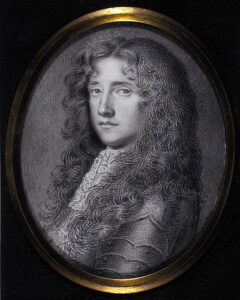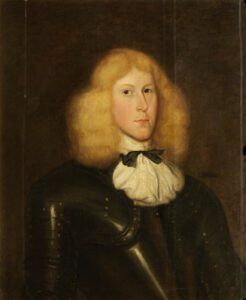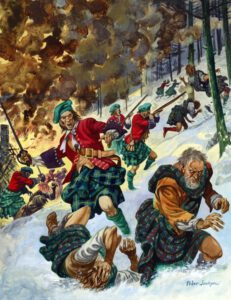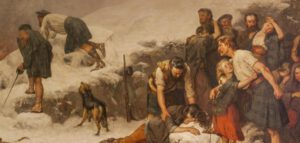The Massacre of Glencoe
February 1692
Prehistory

In 1688, the english Parliament revolted against James VII. (James II. of England) and offered the Crown to William III. from Oranien.
The scottish Parliament hesitated at first, but eventually accepted William as King, while the Highlanders, led by John Graham of Claverhouse (Bonnie Dundee), rebelled against this Decision.
Returning from the ‘Battle of Dunkeld’, Maclains from Glencoe and their Cousins from Glengarry sacked the Lands of Robert Campbell and stole his Livestock, making Campbell’s troubled financial Situation critical. In order to continue providing for his Family, he was forced to take over an Army Command and sue for compensation for the People from Glengarry whom he held responsible.
In May 1690, the Jacobites were defeated in the Battle of Cromdale and the Defeat of James in Ireland ended the Uprising.
On the Condition that they would pledge Allegiance to January 1692, William offered in this regard in August 1691 the Highland Clan´s an Amnesty, which contacted for James in order to ask for his Permission.
James, now in France and planning his Return to Britain, delayed his Decision. However, when it was clear that this would take a while, he allowed the Clan Leaders the Oath of Allegiance.
Some Clans who got the Answer James` a week before Deadline made the Oath immediately.
Alastair MacDonald, Chief of Glencoe, however, waited until the last day before he traveled to ‘Fort William’ in December 1691 to take the Oath. There he asked Commander Colonel Hill if he could take the Oath.
Hill said he was not responsible and MacDonald would have to travel to Inveraray, where he could take the oath in front of Sir Collin Campbell, the Sheriff of Argyll. Hill also provided a Letter of Protection confirming that he arrived in time at Fort William, assuring that no action had been taken against MacDonald in the meantime. After three days, MacDonald arrived in Inveraray, but Campbell was absent and had to wait another three days before accepting the Oath. MacDonald was of the Opinion that he had now complied with the Rules and nothing more would be done against him. However, some within the Government saw this as an Opportunity to crack down on the MacDonalds and eliminate some of their Opponents.
The Massacre

In late January or early February 1692, the 1st and 2nd Company of the Earl of Argyll’s Regiment under the Command of Robert Campbell of Glenlyon was to be billeted at the Clan of the MacDonalds in Glencoe, and hosted as usual in the Highlands.
The majority of the Regiment were Recruits from the Lands of Argyll, but only a minority bore the name Campbell. By his marriage, Captain Campbell was related to MacDonald and was therefore housed in the House of the Clan Chrief. Over the course of 14 days, Campbell visited Alexander MacDonald‘s Home every morning, Alistair MacDonald’s youngest Son, who was married to Campbell’s niece, Robert Roy MacGregor’s sister.
About mid-February, Captain Drummond arrived in Glencoe, but he was reluctant to be involved in an oath-related dispute.
Although Drummond was ranked higher than Campbell, he did not take command, but only delivered orders from Major Duncanson:
“Sir You are hereby ordered to fall upon the rebels, the McDonalds of Glenco, and put all to the sword under seventy. you are to have a speciall care that the old Fox and his sons doe upon no account escape your hands, you are to secure all the avenues that no man escape. This you are to putt in execution att fyve of the clock precisely; and by that time, or very shortly after it, I’ll strive to be att you with a stronger party: if I doe not come to you att fyve, you are not to tarry for me, but to fall on. This is by the Kings speciall command, for the good & safety of the Country, that these miscreants be cutt off root and branch. See that this be putt in execution without feud or favour, else you may expect to be dealt with as one not true to King nor Government, nor a man fitt to carry Commissione in the Kings service. Expecting you will not faill in the full-filling hereof, as you love your selfe, I subscribe these with my hand att Balicholis Feb: 12, 1692
(signed) R. Duncanson
For their Majesties service
To Capt. Robert Campbell of Glenlyon”

With his unsuspecting Victims, Drummond spent the evening and even accepted an invitation from the Clan Leader to eat the next day. When Alistair MacDonald wanted to get up the next morning, he was killed.
His Sons and first of all his Wife were able to escape. Approximately 38 Men were killed in their Homes or on the run. Another 40 Women and Children died from the wintry Weather after their Homes were burned down. Elsewhere, the Hosts were warned by Soldiers, or broke, such as Lieutenants Francis Farquhar and Gilbert Kennedy prefer to execute their saber as the command. In order to cut off the Escape Routes, two additional Departments were ready, but they came too late due to a blizzard. But it is also possible that they deliberately came too late not to have to execute the orders.

In 1695 the incidents were investigated by a Commission.
In scottish Law, there is the criminalization of Murder under abuse of Trust, in which fit the Glencoe Massacre. The goal was to hold those responsible to account, but there were some problems.
King William, who signed the Orders, should not be held responsible, and the Argyll Regiment has since been transferred to France. There it had surrendered to the French, which Campbell, Drummond and Duncanson were not available. The final report of the Commission confirmed the King’s innocence and blamed the Secretary of State John Dalrymple for all. After noting the Commission’s Report, the scottish Parliament declared the Execution of the MacDonalds to be Murder and ordered the Kingdom Security Committee to turn to the King for punishment of those responsible for the massacre while compensating the surviving MacDonalds should.
Ultimately, however, no one was held accountable for the Massacre.
Consequences
The Massacre was used to gain further sympathy for the Jacobite movement, which rekindled in 1745.
With the participation of the Argyll Regiment under the Leadership of Campbell, it was also seen more as Part of the long-standing feud between the MacDonalds and the Campbells, less than Government action.
The Memory of the Massacre and the feud between the Clans still exists today.
By the turn of the Millennium, the Pup ‘Clachaig Inn’ in Glencoe had a Sign No Access for Peddlers and Campbells at the door and Children still learn Never trust a Campbell.
The ‘Clan Donald Society of Edinburgh’ holds a wreath-laying Ceremony on February 13 at the Massacre Memorial, to which Clan Members from all over the world travel.
The Offense shocked not so much by the number of Victims as by the Abuse of Campbell’s hospitality law, and is still seen as a stain on scottish Clan History. The Story and Events surrounding this Tragedy were filmed in the 70s by the MacDonald Stewart Company in ‘The Massacre of Glencoe’.